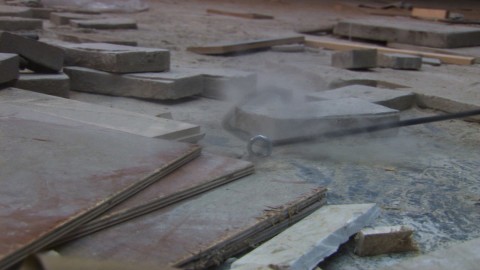Precision and tediousness are qualities that seem diametrically opposed to fun and playfulness, yet they effectively work together in the artwork of Chen Sai Hua Kuan. The laborious preparations of his varied practice result in objects and experiences that delight his audiences.
Born in 1976 in Singapore, Sai recounts, "Since I was a kid, when people tell me I can't do something, I'll generally go and see if I can.” This steadfast, investigative nature drove him to become an artist. In 1997 he graduated from the LASALLE College of the Arts, and he received an MFA from Slade School of the Arts at University College London in 2007. Sai has produced a body of work that crosses disciplinary boundaries of sound, sculpture, drawing, video, performance, and installation. The seeming simplicity of its appearance belies its detailed creation.
Sai’s _Bottles and Fans_ series from 2010 is a sound installation of assemblages comprising several glass bottles and mini travel fans. Similar to the child’s play of blowing on bottles to produce sound, each bottle in the series emits a different tone based on the placement of a running fan atop it and the amount of water it contains. Together they produce a pleasant melody, the orchestration of which necessitates precise placement and measurement of each element.
_No Turn_ (2012) deconstructs and reconstructs bicycles by adjoining two frames to one wheel. Formally balanced and symmetric, the work paradoxically generates frustration as ostensible riders of the inverted tandem would go nowhere. Conversely, the multiple riders of _Going Somewhere 01_ (2012) could travel, but only in the circle formed by eight interconnected bicycles. The seamlessness of the construction also conveys chaos and confusion in the imagining of an attempt to ride it. Moreover, while the arrangements undoubtedly are amusing, they also suggest the Sisyphean aspects of work and life in a fast-paced and aggressive city, such as Singapore.
The senses of being set adrift and unable to find one’s bearings also emerge in the installation _Something Nothing_ (2007). Inspired by a blank piece of white paper, Sai set out to create an experience of the sheet as a three-dimensional space. The result is a white room, the edges of which are curved precisely to reflect light and prevent shadows. In this way, objects inside the space, including visitors, seem to be absorbed by it. Visitors to the space feel as if they are floating, sometimes losing their balance, as the room lacks any reference points on which to focus.
Another installation, _Drawing between Nothing_ (2009), creates a drawing from black bungee cords and magnetic fields across a white room, from floor to ceiling. Positioned at the ends of the ropes, magnets hold the lines of the cords in place, at angles and in mid-air, throughout the space. However, the piece inadvertently can become interactive. According to Wang Ruobing, curator at The National Art Gallery, Singapore, depending on “the level of voice, speed of movement and choice of attire (especially with iron buttons),” a viewer might become a participant.
_Drawing between Nothing_ parallels works from Sai’s site-specific series _Space Drawing_ that have been executed and filmed in China, Russia, Germany, and the United Kingdom since 2007. Shot in Limerick, Ireland, in an abandoned warehouse, _Space Drawing 07_ (2009), in particular, follows the trajectory of a black bungee cord, released to ricochet across the building, high and low, inside and outside. The work broadens the function of a line. The usual two-dimensional form in a drawing extends to a three-dimensional performative event that both maps and enlivens its environment. The cord is an active presence and in fact appears animate as it kicks up dust and slaps against rocks, boxes, and other items in its path.
In a sense, Sai’s "space drawing" formally echoes the spatial sculpture of Fred Sandback's yarn installations. However, Sai theoretically has yanked the threads to also play on the meaning of drawing, as the line (of the bungee cord) is _drawn_ across the warehouse. Further, the effect of this act gives the work Sai’s typical paradoxical twist. That is, in addition to playfulness, the reckless overwhelming force of the rope induces uneasiness as it whips through the space with abandon. At the same time, via its travels, viewers take notice of various details of the abandoned site—the tools, plants, façade, graffiti, and furniture. Rather than seeing the structure as one of decay, we ultimately gain a sense of its past life and future potential. _—Kanitra Fletcher_

